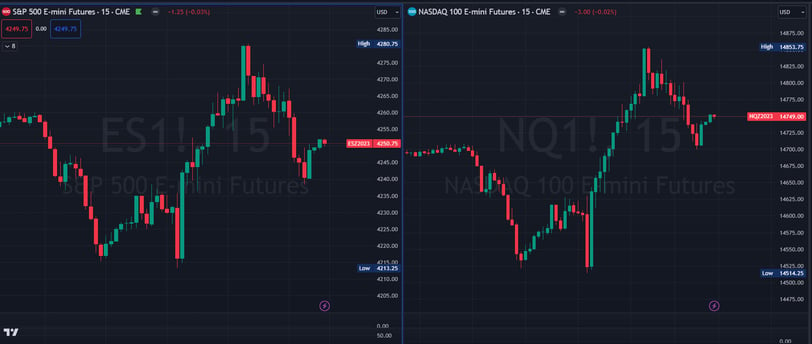Market Review 23rd October 2023
Simplify the craziness
DAILY REVIEW
N
2 min read
The U.S. stock market saw a challenging start to the week, with both the Dow Jones and S&P 500 slipping to nearly five-month lows. This decline came despite a temporary retreat in the 10-year Treasury yield, which had earlier reached a 16-year high of 5%. As an expert stock market and futures trader and a digital marketing specialist, we will delve into the factors driving these market movements and what it means for investors and traders.
Market Performance:
The Dow Jones (DJIA) concluded the day down by 190.87 points, or 0.6%, at 32,936.41, marking its fourth consecutive day of losses.
The S&P 500 (SPX) closed down by 7.12 points, or nearly 0.2%, at 4,217.04, extending its losing streak to five sessions.
The Nasdaq Composite (COMP) bucked the trend, rising by 0.3% to 13,018.33.
These levels represented the lowest closes for the Dow Jones and S&P 500 since May 31.
Market Drivers:
Bond Market Volatility: The 10-year Treasury yield, which had briefly surged above 5%, pulled back to almost 4.84% on Monday. The bond market's roller-coaster ride, with the yield reaching multi-year highs, triggered concerns among investors. Many view the spike as excessive, given the current state of the economy.
Bill Ackman's Tweet: Stocks initially found some relief as Bill Ackman, the head of Pershing Square, announced on Twitter that he had closed his bet against 30-year Treasury bonds. Ackman cited the increased global risk and a slowing economy as reasons for this move. His tweet had a calming effect on the markets.
Middle East Uncertainty: Geopolitical tensions in the Middle East added to the market's unease. Reports from Israel indicated discussions about reevaluating the parameters of a ground invasion in Gaza. This uncertainty amplified concerns about the potential for further escalation in the region.
Oil Prices: Oil futures settled lower, with Brent oil ending below $90 a barrel. The geopolitical tensions in the Middle East have implications for global oil markets, creating additional uncertainty for investors.
Outlook:
The market's response to bond market volatility and geopolitical tensions highlights the fragility of the current economic landscape. Edward Moya of OANDA Corp. believes that this earnings season could bring more optimistic outlooks and that much of the bad news is already priced in. The hope of a peaceful resolution to Middle East conflicts is also helping buoy market sentiment.
The upcoming week will bring crucial economic data releases, including updates on the housing market, economic growth, and the Fed's preferred inflation gauge. Additionally, a slew of earnings reports, including those from tech giants like Microsoft, Google parent Alphabet, Meta Platforms, and Amazon, will have a significant impact on market direction.
Conclusion:
The U.S. stock market's recent performance underscores the sensitivity of investors to bond market fluctuations and geopolitical uncertainties. As a trader, it's crucial to stay informed and adaptable in the face of changing market conditions. Digital marketing experts can also help businesses navigate this environment by tailoring their strategies to address the unique challenges and opportunities presented by the evolving economic landscape.


